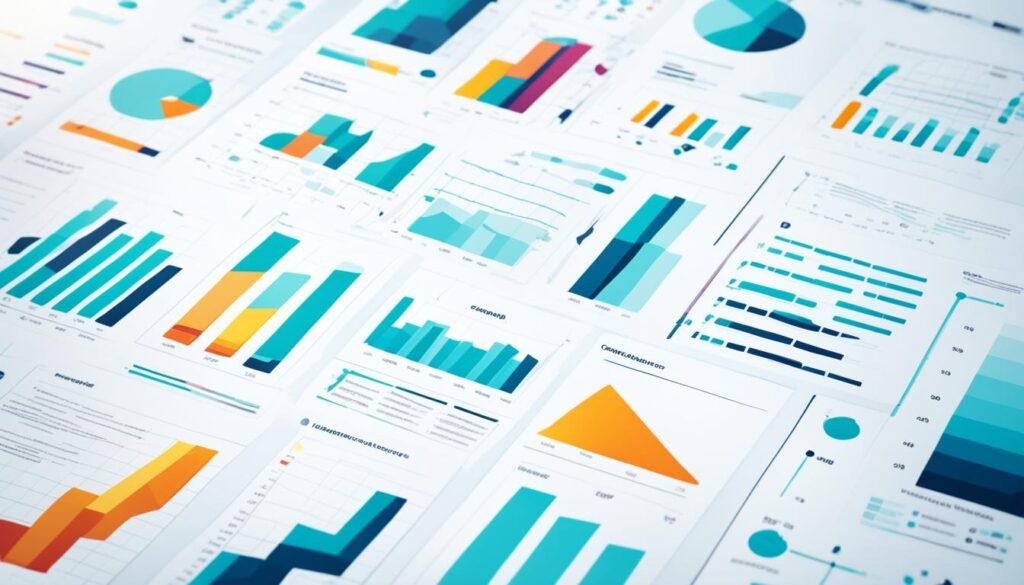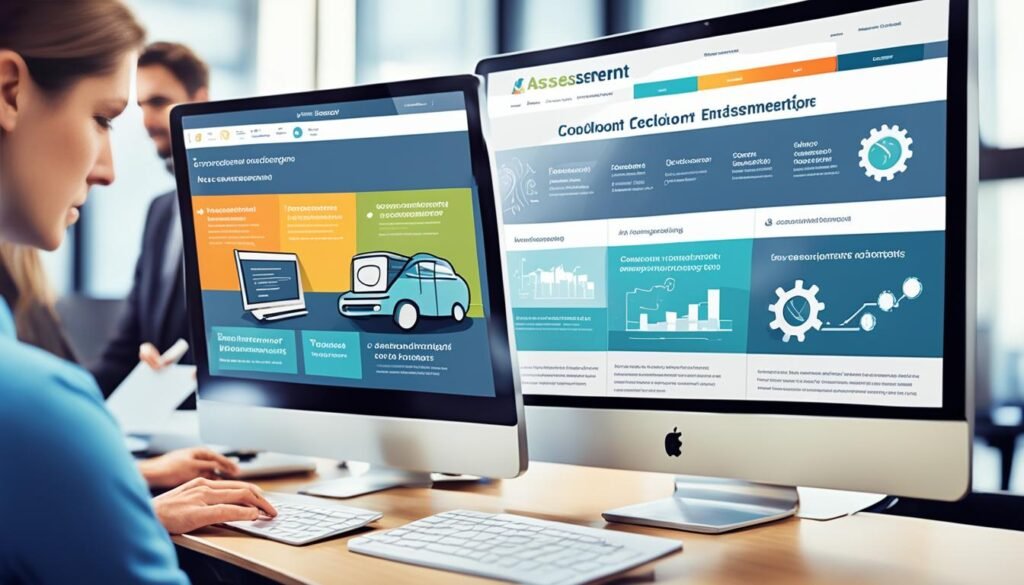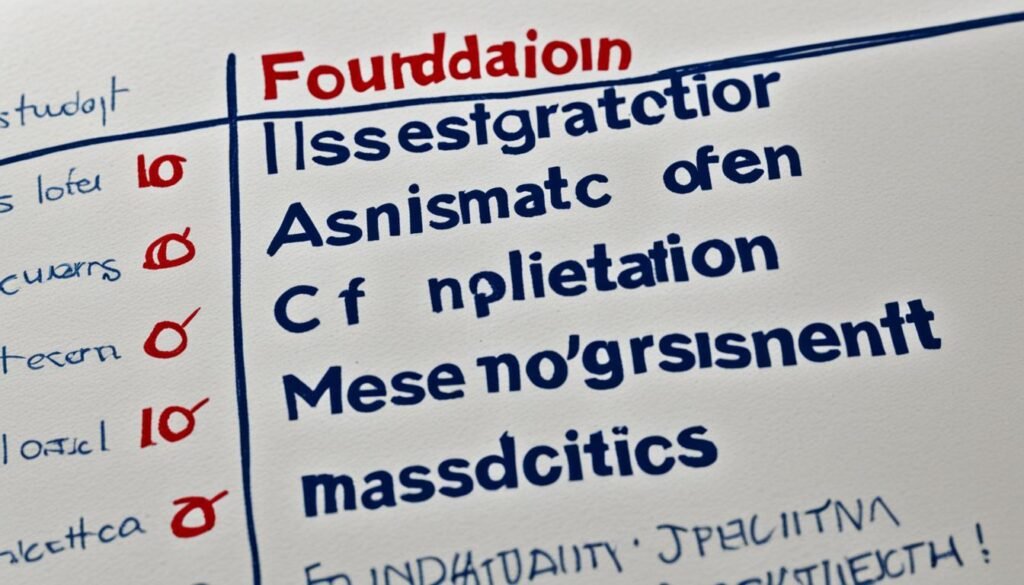Assessment plays a vital role in education, providing valuable insights into student learning outcomes. In today’s rapidly evolving educational landscape, it is essential to stay informed about the latest trends in assessment. Understanding these trends allows institutions to improve the student experience, enhance enrollment and retention rates, and better prepare students for successful careers.
Assessment in education refers to the process of measuring what students know and can do. It involves evaluating student performance, identifying strengths and weaknesses, and gathering actionable data to drive improvement. By implementing effective assessment strategies, institutions can enhance teaching methods, refine curricula, and allocate resources more efficiently.
Let’s delve into the current trends in assessment education and explore how they are reshaping the future of teaching and learning.
Key Takeaways:
- Trends in assessment education have a significant impact on student learning outcomes.
- Assessment measures student performance and provides actionable data for improvement.
- Understanding current assessment trends helps institutions enhance teaching methods and allocate resources effectively.
- Stay informed about the latest assessment trends to improve the student experience and prepare students for successful careers.
- Continuous assessment refinement is crucial for educational institutions aiming to thrive in the ever-changing landscape.
Defining Assessment in Higher Education
Assessment plays a crucial role in higher education by measuring student learning and providing valuable insights for educators and administrators. It encompasses the process of evaluating and measuring the knowledge, skills, and competencies that students acquire during their academic journey. By assessing student learning outcomes, institutions can gain a deeper understanding of how students learn, identify their strengths and weaknesses, and make informed decisions to enhance curricula and teaching methods.
At its core, higher education assessment is a holistic approach that encompasses various methods and tools to measure student achievement and progress. It goes beyond traditional exams and assignments, embracing a comprehensive range of assessment techniques, including projects, presentations, portfolios, and even collaborative activities. This diversified assessment approach allows educators to capture a more accurate representation of a student’s capabilities and growth.
Moreover, higher education assessment goes hand in hand with measuring student learning. It provides educators and administrators with valuable data that allows them to evaluate the effectiveness of their instructional practices and identify areas for improvement. It serves as a feedback mechanism that enables educators to adapt their teaching methods, tailor curricula to meet students’ needs, and ensure that students are equipped with the necessary skills for their future endeavors.
By emphasizing the measurement of student learning, higher education assessment serves as the foundation for institutional effectiveness. It provides institutions with actionable data that can inform resource allocation, program evaluation, and institutional planning. This collaboration between assessment and decision-making helps institutions maintain a continuous cycle of improvement, ensuring that they meet the ever-changing needs of students and society. Ultimately, assessment in higher education is a mutually beneficial process, guiding educators, administrators, and institutions towards their shared goal of fostering student success and enhancing the quality of education.
Trends in Higher Education Assessment

Higher education assessment is evolving to meet the changing needs of students and institutions. Let’s explore the current trends shaping the field of assessment in higher education.
New Assessment Types
In response to the dynamic educational landscape, higher education institutions are shifting towards innovative assessment types. Formative assessments, integrated throughout the course, provide ongoing feedback to students and instructors, allowing for timely intervention and improvement. Strategic assessments, on the other hand, focus on specific outcomes and competencies, providing a comprehensive understanding of student learning.
Data-Driven Innovation
Data-driven decision-making is revolutionizing higher education assessment. Institutions are leveraging data to drive improvements in teaching methods and student outcomes. By analyzing assessment data, educators gain valuable insights into student performance, allowing for targeted interventions and personalized learning experiences. This data-driven approach promotes evidence-based decision-making and continuous improvement.
Proactive Advising and Interventions
One of the key trends in higher education assessment is the use of data to inform proactive advising and interventions for struggling students. Assessment data allows advisors to identify at-risk students early on, enabling timely support and guidance. By leveraging this data, institutions can implement targeted interventions to prevent academic challenges and foster student success.
Leadership and Stakeholder Engagement
Effective leadership and stakeholder engagement play a crucial role in driving assessment improvements. Stakeholder involvement helps foster a culture of improvement and accountability. By engaging leaders and stakeholders in assessment processes, institutions ensure that assessment aligns with the overall goals and mission of the institution.
Inclusivity and Equity
An emerging trend in higher education assessment is the focus on inclusivity and equity. Institutions are taking steps to close equity gaps and ensure that assessments are fair and accessible to all students. Assessments are being designed to reflect diverse perspectives and incorporate a range of knowledge and experiences, allowing students to demonstrate their full potential.
“Assessment is not an end in itself, but a means to improve student learning and promote equitable educational experiences.” – Dr. Angela Johnson, Assessment Specialist
These trends in higher education assessment are shaping the future of education and improving student learning outcomes. By embracing new assessment types, leveraging data-driven innovation, proactive advising, and promoting inclusivity, institutions are better equipped to meet the evolving needs of their students.
| Assessment Trends in Higher Education | Description |
|---|---|
| New Assessment Types | Integrating formative assessments throughout the course and utilizing strategic assessments to assess specific outcomes. |
| Data-Driven Innovation | Leveraging assessment data to drive improvements in teaching methods and student outcomes. |
| Proactive Advising and Interventions | Using assessment data to inform proactive advising and interventions for struggling students. |
| Leadership and Stakeholder Engagement | Fostering a culture of improvement through effective leadership and active engagement from stakeholders. |
| Inclusivity and Equity | Focusing on closing equity gaps and incorporating diverse perspectives in assessment practices. |
These trends highlight the importance of continuous improvement and the role of assessment in shaping the future of higher education.
Data-Driven Approaches in Assessment

Data-driven decision-making is revolutionizing assessment practices in higher education. Institutions are leveraging assessment data to keep students engaged, increase retention rates, and improve overall student outcomes. By utilizing the power of data, educators and administrators can make informed decisions that drive success and enhance the learning experience.
Assessment technology plays a crucial role in enabling data-driven approaches. Advancements in assessment technology provide institutions with more frequent and accurate insights into student and educator performance. This enables timely interventions, tailored instructional strategies, and continuous improvement.
“Assessment technology is transforming the way we understand and support student learning.”
Using assessment data, educators can identify areas of improvement and adjust instructional practices to better meet the needs of their students. By analyzing assessment data, institutions can uncover patterns, trends, and correlations that drive evidence-based decision-making.
Assessment data is no longer restricted to isolated measurements. It is now a valuable resource that informs curriculum planning, guides pedagogical approaches, and facilitates personalized learning experiences. The integration of assessment data into daily teaching practices empowers educators to make data-informed decisions that optimize student engagement and learning outcomes. In turn, students benefit from more targeted support and enhanced academic success.
Benefits of Data-Driven Assessment
Data-driven assessment offers several key benefits:
- Improved instructional practices that are tailored to individual student needs
- Increased student engagement and motivation
- Enhanced curricula based on evidence and insights from assessment data
- Optimized resource allocation for maximum impact
- Streamlined educational planning and decision-making processes
- Greater transparency and accountability in assessing student learning outcomes
Example Data-Driven Assessment Insights
Here’s an example of how assessment data can uncover valuable insights:
| Pre-Assessment Score | Post-Assessment Score | Improvement | |
|---|---|---|---|
| Student A | 70% | 85% | +15% |
| Student B | 50% | 65% | +15% |
| Student C | 80% | 75% | -5% |
From the above table, it is evident that both Student A and Student B showed improvement in their post-assessment scores. These insights can guide educators to further support and challenge these students based on their individual progress. Moreover, the data also highlights the need for additional interventions to help Student C, who experienced a slight decline in performance.
Overall, data-driven assessment empowers educators to optimize learning experiences and tailor interventions to meet the unique needs of each student. It promotes a proactive and evidence-based approach to education, ultimately leading to improved student outcomes.
Proactive Advising and Student Support

Proactive advising plays a crucial role in supporting students and ensuring their success throughout their academic journey. By combining formative assessment data with data-informed strategies, proactive advising models enable educators to identify struggling students and provide them with the necessary support and intervention strategies for improvement.
Early alerts serve as crucial tools in this process, notifying advisors when students are at risk and allowing for timely intervention and support. These alerts, coupled with the use of assessment data, empower advisors to tailor their guidance and counseling to address specific student needs effectively.
Moreover, assessment data can also inform course redesign and improvements, enabling institutions to create learning environments that are conducive to student success. By analyzing the data, educators can identify areas where adjustments may be required, leading to continuous enhancements in teaching methodologies and the overall learning experience.
This proactive approach to advising not only helps students overcome academic challenges but also promotes their overall well-being and personal development. It provides a safety net for struggling students, ensuring that they receive the support they need to thrive in their educational pursuits.
Through proactive advising and dedicated student support, institutions can effectively address barriers to success, enhance student engagement, and promote a culture of achievement and growth. By implementing targeted intervention strategies, educators can empower students to overcome obstacles and reach their full potential.
Next, we will explore the importance of leadership and stakeholder engagement in fostering effective assessment practices within educational institutions.
Increasing Leadership and Stakeholder Engagement

In today’s educational landscape, assessment is no longer viewed as a standalone practice; it has evolved into a culture within institutions. Leaders and stakeholders recognize the value of leveraging data to support student learning, driving institutional effectiveness. Embracing this mindset, institutions are shifting towards effective communication and collaboration with stakeholders, fostering their engagement in assessment practices.
By actively involving stakeholders, institutions gain valuable insights and feedback, enabling them to make informed decisions and improve assessment processes. This collaborative approach promotes a culture of improvement throughout the institution, creating an environment where everyone has a stake in the successful outcomes of students.
“Effective leadership and stakeholder engagement in assessment can transform institutions, empowering educators, administrators, and decision-makers to drive meaningful change.”
Leadership in assessment involves empowering individuals at all levels to take ownership of the assessment process. It requires fostering a shared vision of student success and a commitment to continuous improvement. Engaged leaders inspire educators and stakeholders to embrace assessment as a powerful tool for enhancing teaching and learning.
Stakeholder engagement goes beyond mere participation; it involves actively involving all relevant parties in assessment initiatives. This includes faculty, students, administrators, governing boards, and external partners. Institutions that prioritize stakeholder engagement build trust, transparency, and accountability, ensuring that assessment decisions reflect a collective understanding of institutional goals and values.
Fostering a Culture of Leadership and Engagement
To effectively promote leadership in assessment and stakeholder engagement, institutions can take several strategic actions:
- Establish clear goals and objectives for assessment efforts, ensuring alignment with institutional priorities.
- Create opportunities for leadership development and capacity building in assessment for educators and administrators.
- Implement regular communication channels to keep stakeholders informed about assessment practices, outcomes, and ongoing improvements.
- Encourage open dialogue and collaboration among stakeholders, fostering a diverse range of perspectives and ideas.
- Recognize and celebrate the contributions of leaders and stakeholders in assessment through awards and professional development opportunities.
The Impact of Leadership and Stakeholder Engagement
When institutions prioritize leadership in assessment and stakeholder engagement, they experience several benefits:
- Enhanced decision-making: Involving stakeholders in assessment processes leads to data-driven decisions that align with institutional goals and values.
- Improved student success: Engaged leaders and stakeholders collaborate to identify and implement strategies that support student learning and achievement.
- Increased buy-in and ownership: When stakeholders actively participate in assessment initiatives, they develop a sense of ownership and responsibility for student outcomes.
- Enhanced institutional effectiveness: Leadership in assessment and stakeholder engagement contribute to a culture of continuous improvement, driving overall institutional effectiveness.
Building a Foundation for Success
Leadership in assessment and stakeholder engagement are essential components of a successful assessment culture. By embracing these practices, institutions can harness the power of data to support student learning, improve educational outcomes, and drive institutional effectiveness.
References:
- Smith, J. (2019). The role of leadership in assessment practices. Journal of Higher Education Assessment, 10(2), 45-63.
- Johnson, M. & Thompson, A. (2020). Stakeholder engagement in assessment: A practical guide. Higher Education Today, 24(3), 89-104.
| Leadership in Assessment | Stakeholder Engagement | Institutional Effectiveness |
|---|---|---|
| Leadership development | Engaging faculty | Data-driven decision-making |
| Shared vision | Involving students | Improved student success |
| Capacity building | Administrative involvement | Institutional effectiveness |
| Communication channels | Governing boards | Informed decision-making |
| Recognition and celebration | External partners | Culture of improvement |
Promoting Inclusivity in Assessment

Inclusive assessment practices are crucial in fostering an equitable learning environment that caters to students from diverse backgrounds. Recognizing that students may have unique needs, these practices prioritize equitable access to learning experiences and resources, promoting a fair assessment process for all.
Assessments are becoming more inclusive and equitable, recognizing that students from diverse backgrounds may require additional support and resources.
Equity gaps in student performance and outcomes are identified and addressed through the disaggregation of assessment findings. This allows institutions to target and close these gaps, ensuring that all students have equal opportunities to succeed.
Inclusive assessment practices also take into account the diverse perspectives of students. By providing multiple ways for students to demonstrate their knowledge and skills, assessments enable individuals to showcase their full potential in a way that aligns with their unique strengths and abilities.
Incorporating Diverse Perspectives
One of the key aspects of promoting inclusivity in assessment is the incorporation of diverse perspectives. By embracing diverse voices and experiences, assessments become more representative of the realities and identities of students, creating a more inclusive and enriching learning environment.
Incorporating diverse perspectives can be achieved through:
- Designing assessment tasks that allow for multiple interpretations and approaches.
- Including culturally relevant content and references in assessments.
- Encouraging students to share their personal experiences and perspectives as part of their assessment responses.
By embracing these practices, institutions can create a more inclusive assessment ecosystem that empowers students from diverse backgrounds to thrive and succeed.
Inclusive assessment practices play a crucial role in creating a fair and supportive learning environment for all students. By recognizing the needs of diverse learners and incorporating their perspectives, assessments can truly reflect and celebrate the richness and diversity of human experiences. Through a commitment to equitable assessment practices, institutions can ensure that every student has an equal opportunity to demonstrate their knowledge and skills.
Expanding Career-Related Experiences in Assessment

Institutions are recognizing the importance of preparing students for successful careers beyond academic achievements. To achieve this, experiential learning activities such as internships and service learning are being incorporated into assessment practices. However, assessing these unique experiences requires a different approach that aligns with career goals and helps students make informed choices.
Assessment for career goals involves measuring specific skills that are essential for success in the workforce. By evaluating competencies related to AI and technology, institutions ensure that students are equipped with the necessary skills required by the modern job market.
This image depicts students engaged in experiential learning activities, showcasing the practical aspect of career readiness. It visually represents the importance of integrating real-world experiences into the assessment process.
In addition to skill assessment, institutions are also providing guidance and resources to help students align their interests and aspirations with career opportunities. By assessing career goals, institutions can tailor educational programs and support services to meet the specific needs of each student.
The table below illustrates how assessment for career goals aligns with the skills and competencies that students develop through experiential learning activities:
| Career Readiness Skills | Experiential Learning Activities | |
|---|---|---|
| Communication | Effective verbal and written communication skills | Collaborative projects, presentations, and reports |
| Critical Thinking | Analytical and problem-solving abilities | Research projects, case studies, and simulations |
| Leadership | Ability to lead and influence others | Team projects, group assignments, and leadership roles |
| Adaptability | Flexibility and resilience in a changing environment | Internships, service learning, and real-world experiences |
| Technical Skills | Proficiency in specific tools and technologies | Hands-on training, industry certifications, and workshops |
By integrating career-related experiences into the assessment process, institutions are better preparing students for the demands of the future workforce. The combination of academic knowledge, practical skills, and career guidance ensures that students are equipped to excel in their chosen fields.
As assessment practices continue to evolve, the focus on career readiness and experiential learning will play a vital role in shaping the educational landscape and preparing students for successful careers.
Leveraging Technology for Assessment Improvements

In the rapidly evolving landscape of education, assessment practices are embracing technology to drive improvements and enhance student learning outcomes. The shift from manual assessments to digital processes has opened up new possibilities for more frequent and secure assessment opportunities.
The integration of assessment technology allows educational institutions to collect actionable data and gain valuable insights into student and educator performance. By leveraging digital assessment tools, educators can gather comprehensive data on student progress, identify areas of strength and weakness, and tailor instruction to meet individual needs.
Digital assessment offers numerous advantages over traditional assessment methods. It provides real-time feedback to students, enabling them to track their progress and make necessary adjustments. It also reduces administrative burden by automating grading and data analysis, allowing educators to spend more time on instruction and personalized support.
Benefits of Digital Assessment:
- Immediate feedback: Students receive instant feedback on their assessments, enabling them to identify areas for improvement and take corrective actions in real-time.
- Enhanced engagement: Digital assessment platforms often incorporate interactive elements such as multimedia content, simulations, and gamification, making assessments more engaging and motivating for students.
- Data-driven insights: Through the use of digital assessment tools, educators gain access to comprehensive data and analytics that provide valuable insights into student performance, learning trends, and instructional effectiveness.
- Personalization: Digital assessment allows for adaptive and personalized learning experiences, tailoring instruction based on individual student needs and preferences.
- Evidence-based decision-making: The collection and analysis of assessment data enable educators and administrators to make informed decisions about curriculum design, instructional strategies, and resource allocation.
“Digital assessment provides educators with a wealth of data-driven insights that can significantly impact teaching and learning outcomes,” says Dr. Emily Thomas, an expert in educational technology. “By harnessing technology, educators can deliver more personalized instruction and empower students to take ownership of their learning.”
The integration of digital assessment tools into the educational ecosystem holds immense potential for transforming teaching and learning. From formative assessments to summative evaluations, technology-enabled assessments pave the way for a more efficient, effective, and student-centered approach to education.
The image above visually represents the seamless integration of technology in the assessment process, highlighting the key role it plays in empowering educators and students alike.
Professional Development in Assessment

Ongoing professional development is crucial for educators to stay updated with the latest assessment practices and enhance their capacity in this field. Through workshops, partnerships, and collaboration with assessment experts, institutions ensure that educators have the necessary tools, knowledge, and support to implement effective assessment strategies.
Professional development opportunities enable educators to deepen their understanding of data-driven approaches, explore innovative assessment methods, and refine their skills in using assessment technology. By engaging in continuous learning and development, educators can foster a collaborative environment that promotes cohesive assessment practices.
Capacity building in assessment benefits not only educators but also decision-makers, administrators, and ultimately, students. When educators are equipped with the expertise to implement meaningful assessments, institutions can gather valuable data to inform instructional practices, support student success, and drive institutional improvement.
Investing in professional development in assessment demonstrates the commitment of institutions to provide high-quality education and meet the evolving needs of students. By prioritizing ongoing learning, institutions can ensure that assessment practices align with current trends and best practices. This proactive approach to professional development fosters a culture of assessment and continuous improvement throughout the institution.
The Benefits of Professional Development in Assessment
By actively engaging in professional development in assessment, educators can:
- Keep pace with emerging trends and best practices in assessment
- Enhance their knowledge and skills in data-driven decision-making
- Improve their proficiency in using assessment technology
- Collaborate with peers to share insights and strategies
- Develop a deeper understanding of student learning and development
- Implement effective assessment strategies to support student success
Professional development in assessment empowers educators to design assessments that align with learning objectives, promote student engagement, and provide actionable data for informed decision-making. It equips educators with the tools and resources needed to navigate the complexities of assessment practices and meet the diverse needs of their students.
Professional development is an investment in the success of educators and students alike. By continually expanding our knowledge and skills in assessment, we can create meaningful learning experiences and drive positive outcomes for our students.
As the field of assessment continues to evolve, ongoing professional development remains crucial. By investing in the growth and development of educators, institutions can build a solid foundation for assessment practices that positively impact student learning and success.
| Benefits of Professional Development in Assessment |
|---|
| 1. Enhanced knowledge and skills in assessment |
| 2. Improved proficiency in data-driven decision-making |
| 3. Increased ability to use assessment technology effectively |
| 4. Opportunities for collaboration and sharing of insights |
| 5. Deeper understanding of student learning and development |
| 6. Implementation of effective assessment strategies |
Recognizing the Value of Assessment

Assessment work plays a crucial role in driving sustained improvement in educational institutions. To truly embed assessment into the institutional culture, it is essential to recognize and value the efforts put into assessment practices. Institutions are now taking proactive steps to ensure that recognition and rewards are aligned with their mission statements, fostering a culture of continuous improvement.
One way institutions are recognizing assessment work is through external recognitions, such as the Excellence in Assessment Designation. This designation acknowledges and celebrates institutions that have made significant progress in developing and implementing effective assessment practices. By receiving this recognition, institutions demonstrate their commitment to excellence in student learning outcomes.
However, external recognitions are not the only avenue for recognizing assessment work. Institutions are complementing them with internal recognitions to further promote assessment practices within their own communities. By acknowledging the efforts of faculty, staff, and administrators involved in assessment, institutions are encouraging a culture that values assessment as an integral part of the teaching and learning process.
“Recognition and rewards for assessment work create a virtuous cycle, motivating and inspiring individuals to continue engaging in assessment practices that contribute to institutional effectiveness and student success.”
– Dr. Anna Smith, Assessment Specialist
These internal recognitions may take various forms, such as awards, certificates, or public acknowledgments. They highlight individuals or teams that have effectively used assessment data to improve teaching, enhance learning outcomes, or make other meaningful contributions to the institution. By publicly celebrating their achievements, institutions inspire others to engage in assessment work and contribute to a culture of continuous improvement.
Embedding Assessment into Institutional Culture
Recognizing the value of assessment means going beyond mere acknowledgment. Institutions must strive to embed assessment into their institutional culture. This involves creating an environment where assessment is not viewed as a standalone practice but as an integral part of the institution’s mission and values.
Embedding assessment into the institutional culture requires a strategic approach that involves leadership, faculty, staff, and students. It begins with clear communication, ensuring that all stakeholders understand the importance of assessment and its impact on student learning. By actively involving everyone in the assessment process, institutions can foster a sense of ownership and shared responsibility for continuous improvement.
Furthermore, integrating assessment into instructional practices, curriculum development, and decision-making processes helps establish assessment as a core component of the institution’s operations. By aligning assessment with the institution’s strategic priorities, policies, and practices, institutions can ensure that assessment becomes deeply ingrained in the way they operate.
As assessment becomes embedded in the institutional culture, it becomes a natural and routine part of the educational experience. Students engage in assessment activities with a clear understanding of their purpose and value. Faculty members incorporate assessment into their teaching practices, using data to inform instructional decisions and improve student learning outcomes. Administrators rely on assessment data to make informed decisions that drive institutional effectiveness.
Ultimately, recognizing the value of assessment and embedding it into the institutional culture paves the way for continuous improvement and better student learning outcomes. It creates a community of educators and learners who actively participate in the assessment process, leveraging data to enhance teaching, learning, and institutional effectiveness.
Also Read : Navigate Your Way to Apply to Education Effectively
Conclusion
Assessment in education is a dynamic field that continually adapts to meet the evolving needs of students and institutions. The trends in assessment demonstrate a shift towards innovative assessment types, data-driven approaches, proactive advising, leadership and stakeholder engagement, inclusivity, career readiness, technology integration, professional development, and recognition of assessment’s value.
By embracing these trends, assessment practices can effectively shape the future of education and drive improvements in student learning outcomes. New assessment types, such as formative assessments and strategic assessments, provide educators with valuable insights into students’ progress and areas for improvement. Data-driven approaches enable institutions to make informed decisions, enhance teaching practices, and support student success.
Proactive advising and engagement initiatives ensure that students receive the support they need throughout their educational journey. Inclusivity in assessment promotes equity and creates a more inclusive learning environment for students from diverse backgrounds. By prioritizing career readiness and incorporating technology, assessment practices prepare students for the modern workforce.
Continuous professional development empowers educators to implement effective assessment strategies and leverage technology to enhance student engagement and inform curriculum development. Recognizing the value of assessment work and embedding it into the institutional culture fosters a culture of improvement and drives sustainable success.
FAQs
Q: What is student assessment?
A: Student assessment is the process of evaluating students’ knowledge, skills, and abilities in a particular subject or area of study.
Q: How can assessment data help in evaluating student progress?
A: Assessment data provides valuable insights into student performance, allowing educators to track progress, identify areas for improvement, and make informed instructional decisions.
Q: What are some common forms of assessment used in education?
A: Common forms of assessment in education include examinations, norm-referenced assessments, ipsative assessments, and assessments for learning.
Q: What is the difference between formative and summative assessment?
A: Formative assessment is used during the learning process to monitor progress and provide feedback, while summative assessment takes place after learning to evaluate student achievement against predetermined criteria.
Q: How can assessment be used to measure learning outcomes?
A: Assessment can help educators measure whether students have achieved specific learning goals, assess the effectiveness of their teaching methods, and determine if learning progress is being made.
Q: Why is assessment considered a critical component of education?
A: Assessment is a critical component of education as it provides valuable feedback on student learning, guides instructional strategies, and ensures that learning goals are being met.
Q: What are different methods of assessment that can be used in the classroom?
A: Different methods of assessment include formative assessment, summative assessment, ipsative assessment, and assessment as learning, each serving unique purposes in evaluating student performance.
Q: What are the basic types of assessment in education?
A: The basic types of assessments in education include formative assessment, diagnostic assessment, and summative assessment.
Q: How does formative assessment differ from summative assessment?
A: Formative assessment is used to monitor students’ learning throughout the school year, while summative assessments occur at the end of a unit of study to evaluate student learning.
Q: How can assessments help teachers in the classroom?
A: Assessments can help teachers see if their teaching is effective, identify students’ strengths and weaknesses, and adjust their teaching strategies accordingly.
Q: What is diagnostic assessment and how is it used in education?
A: Diagnostic assessment is a type of formative assessment that helps teachers identify students’ areas of strengths and weaknesses at the beginning of a unit of study.
Q: What is ipsative assessment and when should it be considered?
A: Ipsative assessment is designed to measure a student’s progress against their own previous performance. It should be considered when teachers want to focus on individual growth rather than comparing students to each other.
Q: Why is it important for students to be aware of the purpose of an assessment?
A: Students should know or be able to understand the purpose of an assessment so that they can better engage with the learning process and see the value in their evaluations.
Q: How can informal formative assessments be incorporated into classroom practices?
A: Informal formative assessments, such as using a sticky note exit ticket or asking students to summarize their learning, can be easily integrated into daily classroom activities to gauge students’ understandi
Source Links
- https://planning.iupui.edu/assessment/prac-files/minutes/2019-20/nov19minutes.pdf
- https://www.watermarkinsights.com/resources/blog/assessment-trends-higher-education
- https://www.erblearn.org/blog/future-of-assessment-trends/




